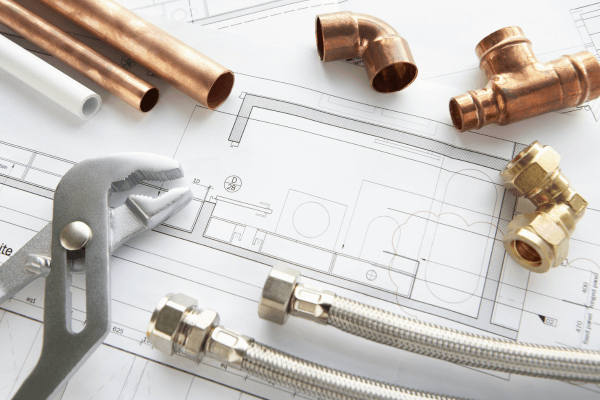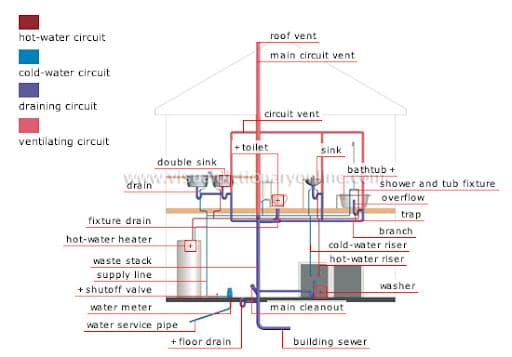The Essential Elements of Your House's Plumbing System
The Essential Elements of Your House's Plumbing System
Blog Article
The content following next on the subject of The Inner Workings of Your Home's Plumbing is quite insightful. Have a go and draw your own personal assumptions.

Recognizing how your home's pipes system functions is essential for each homeowner. From delivering tidy water for alcohol consumption, food preparation, and showering to securely removing wastewater, a properly maintained pipes system is critical for your family's health and wellness and comfort. In this extensive guide, we'll check out the elaborate network that comprises your home's plumbing and offer tips on upkeep, upgrades, and managing typical problems.
Introduction
Your home's plumbing system is more than just a network of pipes; it's a complicated system that ensures you have access to clean water and efficient wastewater removal. Recognizing its parts and just how they work together can aid you prevent costly repairs and ensure everything runs efficiently.
Fundamental Parts of a Plumbing System
Pipes and Tubing
At the heart of your plumbing system are the pipelines and tubes that lug water throughout your home. These can be made from various materials such as copper, PVC, or PEX, each with its benefits in terms of sturdiness and cost-effectiveness.
Components: Sinks, Toilets, Showers, and so on.
Fixtures like sinks, bathrooms, showers, and bath tubs are where water is made use of in your home. Comprehending exactly how these components attach to the pipes system aids in detecting issues and intending upgrades.
Shutoffs and Shut-off Points
Valves regulate the circulation of water in your pipes system. Shut-off valves are crucial throughout emergency situations or when you need to make repair work, allowing you to isolate parts of the system without disrupting water circulation to the whole home.
Water System
Main Water Line
The main water line attaches your home to the local supply of water or a private well. It's where water enters your home and is distributed to various components.
Water Meter and Stress Regulator
The water meter actions your water usage, while a stress regulatory authority makes certain that water flows at a safe stress throughout your home's pipes system, preventing damage to pipelines and components.
Cold Water vs. Hot Water Lines
Understanding the difference in between cold water lines, which supply water directly from the major, and warm water lines, which bring heated water from the hot water heater, assists in troubleshooting and planning for upgrades.
Water drainage System
Drain Pipes Pipeline and Traps
Drain pipes carry wastewater far from sinks, showers, and toilets to the sewer or septic system. Traps prevent sewage system gases from entering your home and likewise trap particles that might trigger obstructions.
Ventilation Pipes
Air flow pipes allow air into the drainage system, protecting against suction that might slow water drainage and trigger catches to empty. Correct ventilation is necessary for maintaining the stability of your plumbing system.
Importance of Appropriate Water Drainage
Making certain proper water drainage prevents backups and water damages. Regularly cleaning up drains pipes and maintaining catches can protect against costly repair services and extend the life of your plumbing system.
Water Furnace
Sorts Of Hot Water Heater
Water heaters can be tankless or conventional tank-style. Tankless heating units warm water as needed, while tanks keep warmed water for prompt use.
Upgrading Your Pipes System
Factors for Upgrading
Upgrading to water-efficient components or changing old pipes can enhance water quality, reduce water expenses, and boost the worth of your home.
Modern Plumbing Technologies and Their Benefits
Check out modern technologies like smart leak detectors, water-saving bathrooms, and energy-efficient hot water heater that can conserve cash and reduce environmental effect.
Price Considerations and ROI
Calculate the upfront expenses versus long-lasting cost savings when taking into consideration plumbing upgrades. Lots of upgrades spend for themselves through minimized energy bills and less fixings.
How Water Heaters Link to the Pipes System
Understanding how hot water heater attach to both the cold water supply and warm water distribution lines helps in identifying concerns like insufficient hot water or leakages.
Upkeep Tips for Water Heaters
Regularly flushing your water heater to get rid of debris, checking the temperature setups, and evaluating for leakages can expand its lifespan and improve energy effectiveness.
Usual Pipes Issues
Leaks and Their Causes
Leaks can happen as a result of maturing pipelines, loose installations, or high water pressure. Attending to leakages without delay stops water damages and mold and mildew growth.
Blockages and Blockages
Clogs in drains and commodes are usually brought on by purging non-flushable products or an accumulation of oil and hair. Making use of drainpipe displays and bearing in mind what decreases your drains can prevent clogs.
Indicators of Pipes Issues to Watch For
Low water pressure, slow drains pipes, foul odors, or uncommonly high water bills are indicators of prospective pipes issues that ought to be resolved immediately.
Plumbing Upkeep Tips
Routine Inspections and Checks
Arrange annual plumbing inspections to catch concerns early. Seek indicators of leakages, rust, or mineral accumulation in taps and showerheads.
Do It Yourself Upkeep Tasks
Easy tasks like cleaning faucet aerators, looking for commode leakages utilizing dye tablet computers, or shielding subjected pipes in cold climates can protect against significant plumbing concerns.
When to Call a Specialist Plumbing
Know when a plumbing problem requires professional experience. Trying complicated repairs without correct expertise can lead to even more damages and higher fixing expenses.
Tips for Reducing Water Usage
Simple habits like dealing with leakages promptly, taking much shorter showers, and running complete loads of washing and meals can save water and lower your utility bills.
Eco-Friendly Pipes Options
Think about lasting plumbing products like bamboo for flooring, which is durable and environmentally friendly, or recycled glass for kitchen counters.
Emergency situation Preparedness
Steps to Take During a Pipes Emergency situation
Know where your shut-off valves lie and how to shut off the water in case of a ruptured pipe or significant leakage.
Relevance of Having Emergency Get In Touches With Convenient
Keep contact information for regional plumbers or emergency situation services easily available for fast response during a pipes dilemma.
Ecological Impact and Preservation
Water-Saving Fixtures and Appliances
Setting up low-flow faucets, showerheads, and toilets can substantially lower water usage without giving up performance.
Do It Yourself Emergency Situation Fixes (When Appropriate).
Momentary solutions like utilizing air duct tape to patch a leaking pipeline or placing a container under a leaking tap can decrease damages until an expert plumbing professional arrives.
Final thought.
Recognizing the anatomy of your home's pipes system encourages you to maintain it properly, saving time and money on repair services. By complying with normal upkeep regimens and remaining notified concerning modern pipes modern technologies, you can guarantee your pipes system runs successfully for years ahead.
HOW YOUR PLUMBING SYSTEM WORKS
Which Pipes Do What?
Blue lines = fresh water supply entering the building Red lines = hot water supply entering the building Grey lines = pipes carrying waste away from the building and venting pipes carrying gases away from the building (through the roof) YOUR MAIN PLUMBING SYSTEMS
There are two main plumbing systems that support your home s basic plumbing needs one that brings clean water into your home, and one that sends dirty water away from your home. Connected to the toilet, bath, shower, and other faucets in your home, these two systems keep your water flowing in the right directions.
ACCESSING FRESH WATER
Fresh and clean water is brought into your home through the main water supply line . Filtered through one pipe, this water is pressured to flow into the various fixtures in your home at any given time.
This water can be sourced from a well located on your property, a pond or river (mostly cottages), or, as in most cases, from the city s municipal water treatment centre. However, it is important to note that water that is untreated, such as the water siphoned from ponds or rivers, may not be safe to drink. Personal water supplies always need to be treated for hardness and contaminants before consumed.
MUNICIPAL WATER SUPPLIES
Improve taste and odour Remove sediment Eliminate hardness Reduce chlorine COLD WATER SUPPLY VS. HOT WATER SUPPLY
Cold water flows into your home or building through the service line, which then distributes hot or cold water to your fixtures. This line is most commonly run through a central column that runs floor to floor. Hot water runs in short and straight pipes as the longer the pipeline, the more heat that will be lost in the transfer. Having shorter pipes also allows residents to access hot water more quickly.
WASTE WATER SYSTEM
Your wastewater system is divided into two parts pipes that send wastewater away from your home and venting pipes that send sewer gas away from your home. Sewage water travels through pipes that flush the water and waste towards local sewers that are operated and managed by your city or town. Most sewer systems rely on gravity to move the wastewater to where it needs to go.
The further away from your toilet or sink, the larger wastewater pipes become. This allows for waste to be disposed of from various parts of your home or business at once without pipe blockages. The angle and flow of these pipes are also essential for keeping your waste pipes clear of build up.
https://harrisplumbing.ca/how-your-home-plumbing-system-works/

I'm just very serious about Understanding Your Home's Plumbing Anatomy and I hope you appreciated our blog post. Are you aware of another individual who is serious about the topic? Do not hesitate to promote it. Thanks for your time spent reading it.
Schedule And Pricing Report this page